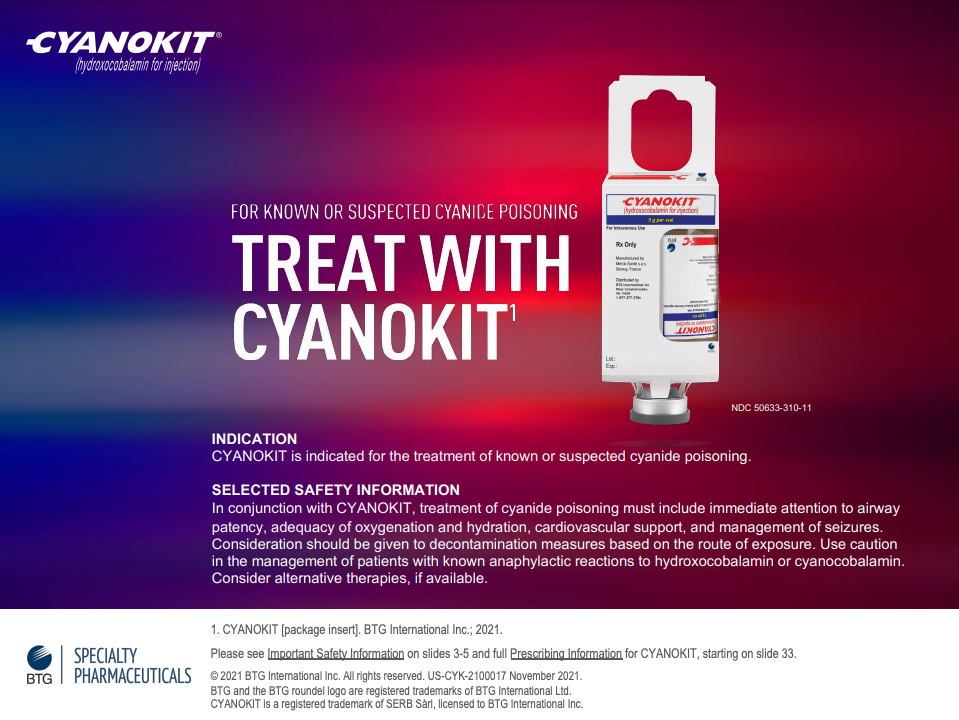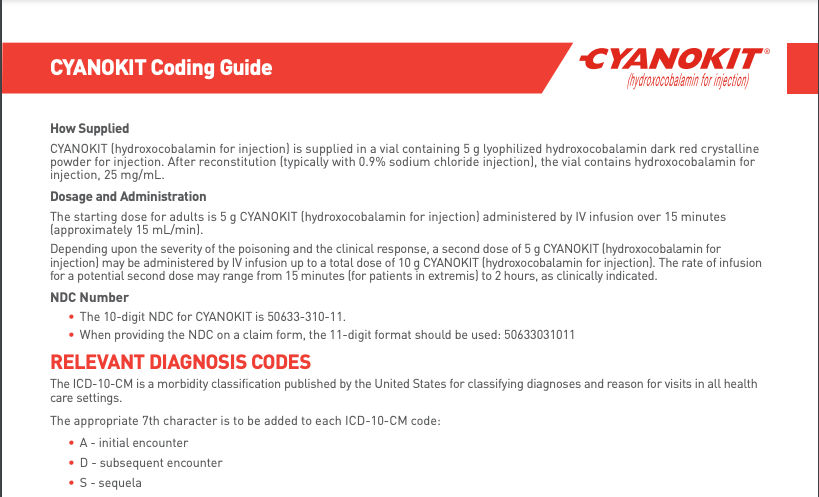INDICATION
CYANOKIT is indicated for the treatment of known or suspected cyanide poisoning.
Important Safety Information and Indication
WARNINGS AND PRECAUTIONS
Emergency Patient Management
- In conjunction with CYANOKIT, treatment of cyanide poisoning must include immediate
attention to airway patency, adequacy of oxygenation and hydration, cardiovascular
support, and management of seizures. Consideration should be given to
decontamination measures based on the route of exposure.
Risk of Anaphylaxis and Other Hypersensitivity Reactions
- Consider alternative therapies, if available, in patients with known anaphylactic
reactions to hydroxocobalamin or cyanocobalamin.
- Allergic reactions may include: anaphylaxis, chest tightness, edema, urticaria,
pruritus, dyspnea, and rash. Allergic reactions including angioneurotic edema have
also been reported in postmarketing experience.
Risk of Renal Injury
- Acute renal failure with acute tubular necrosis, renal impairment and urine calcium
oxalate crystals have been reported following CYANOKIT therapy. Monitor renal
function for 7 days following CYANOKIT therapy.
Risk of Increased Blood Pressure
- Substantial increases in blood pressure may occur following CYANOKIT therapy.
Monitor blood pressure during therapy.
Laboratory Tests
- Because of its deep red color, hydroxocobalamin has been found to interfere with
colorimetric determination of certain laboratory parameters (e.g., clinical
chemistry, hematology, coagulation, and urine parameters). Be aware of this when
reporting and interpreting laboratory results.
- While determination of blood cyanide concentration is not required for management of
cyanide poisoning and should not delay treatment with CYANOKIT, collecting a
pretreatment blood sample may be useful for documenting cyanide poisoning as
sampling post-CYANOKIT use may be inaccurate.
Clinical Methods
- Because of its deep red color, hydroxocobalamin may cause hemodialysis machines to
shut down due to an erroneous detection of a "blood leak". This should be considered
before hemodialysis is initiated in patients treated with hydroxocobalamin.
Photosensitivity
- Hydroxocobalamin absorbs visible light in the UV spectrum. It therefore has
potential to cause photosensitivity. While it is not known if the skin redness
predisposes to photosensitivity, patients should be advised to avoid direct sun
while their skin remains discolored.
Pregnancy and Lactation
- Available data from cases reported in the published literature and postmarketing
surveillance with CYANOKIT use in pregnant women are insufficient to identify a
drug-associated risk for major birth defects, miscarriage, or adverse maternal and
fetal outcomes. There are risks to the pregnant woman and fetus associated with
untreated cyanide poisoning. In animal studies, hydroxocobalamin administered to
pregnant rats and rabbits during the period of organogenesis caused skeletal and
soft tissue abnormalities, including alterations in the central nervous system, at
exposures similar to human exposures at the therapeutic dose.
- Breastfeeding is not recommended during treatment with CYANOKIT.
ADVERSE REACTIONS
- The most common adverse reactions (>5%) include transient chromaturia, erythema,
oxalate crystals in urine, rash, increased blood pressure, nausea, headache and
infusion site reactions.





